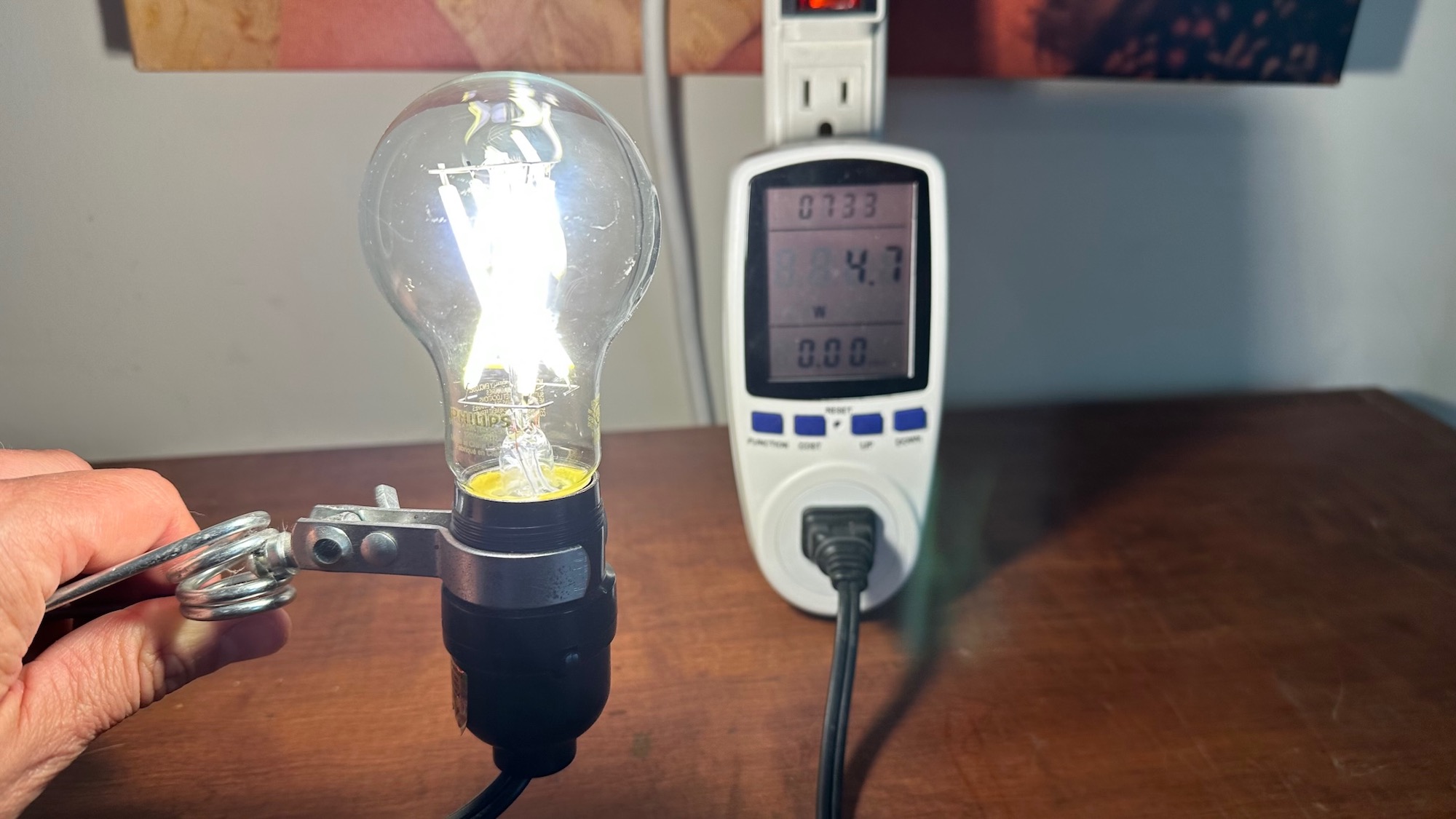Philips' new LED light bulb could cut your electric bill in half
Hands-on with the new Philips Ultra Efficient LED bulb

One of the easiest ways to cut your electricity bill is to switch your lights from incandescent to LEDs, which use far less energy — and are rated to last far longer — than older types of bulbs.
But, even among LED bulbs, there are some that are more efficient than others. Philips new Ultra Efficient LED bulbs are just that. These new lights, which just went on sale, use just 4.5 watts of energy, which is about half as much as some of the more popular LED bulbs available today. Philips estimates the bulbs will cost you as little as 55 cents per year, and will last up to 45.7 years.
Philips sent me a bulb to check out for myself, so I hooked it up to an energy meter to see how it compared to other LED bulbs, and to see how bright it was.
Philips Ultra Efficient LED bulbs: Price and availability
The Philips Ultra Efficient LED bulb comes in three sizes (A19, A21, and BR30) and two color temperatures (3000K) soft white and 5000K daylight). Currently, the bulbs are being sold exclusively at Walmart.
- 60W A19 Bulb: Soft White (3000K) and Daylight (5000K) – $9.97, $16.97 for two-pack
- 100W A21 Bulb: Soft White (3000K) and Daylight (5000K) – $14.97
- 65W BR30 Bulb: Soft White (3000K) and Daylight (5000K) – $10.97
Philips Ultra Efficient LED bulbs: Performance

The packaging for the A19 Ultra Efficient LED states that the bulb emits 810 lumens of brightness, and will cost you an estimated 55 cents per year if you use it for three hours each day (based on a utility rate of 11 cents/kilowatt hour). Philips also says the bulb should last for up to 45.7 years, if you only use it three hours per day.
So how does that compare to some other LED bulbs on the market?
| Row 0 - Cell 0 | Philips Ultra Efficient LED | Amazon Basics A19 LED | EcoSmart A19 LED | Sylvania LED A19 |
| Price/bulb | $8.48 (2-pack) | $3.35 (2-pack) | $1.44 (4-pack) | $3.23 (2-pack) |
| Energy use | 4.5 watts | 9 watts | 9.5 watts | 8.5 watts |
| Est. cost/year | $0.55 | $1.08 | $1.14 | $1.02 |
| Lifespan | 45.7 years | 9 years | 13.7 years | 10 years |
| Dimmable | No | Yes | Yes | No |
To test one of the company's claims, I connected the Ultra Efficient bulb to a WhatsApp power meter to see how much juice the bulb was actually drawing. In my test, the Ultra Efficient bulb drew 4.7 watts — not quite as low as Philips' claims, but close. I then screwed in a Philips Hue White 800-lumen smart LED, which drew 10.2 watts of power.
However, there are a few caveats. For one, the Ultra Efficient LED bulbs are not dimmable. And, rather than an opaque shell, these are clear, so you can see the LED filaments, much like with an Edison-style bulbs. While most bulbs are destined to be covered by a lamp shade, the Ultra Efficient's design may turn off those who want a more traditional look.
Note that the Philips bulbs are fairly expensive upfront. At nearly $10 per bulb (less if you buy them in a two-pack), they cost more than twice as much as similar bulbs. In fact, you can get a Philips Wi-Fi smart LED for just one dollar more; while this bulb doesn't work with the Philips Hue app, you can still control it with Alexa, Google Assistant, and Siri.
I don't have the time to put its 47.5-year lifespan to the test, but that's substantially longer than what most other companies claim. If it's accurate, then it could more than offset the bulb's higher cost — and you can leave the lightbulb to your heirs.
More from Tom's Guide
Sign up to get the BEST of Tom's Guide direct to your inbox.
Get instant access to breaking news, the hottest reviews, great deals and helpful tips.

Michael A. Prospero is the U.S. Editor-in-Chief for Tom’s Guide. He oversees all evergreen content and oversees the Homes, Smart Home, and Fitness/Wearables categories for the site. In his spare time, he also tests out the latest drones, electric scooters, and smart home gadgets, such as video doorbells. Before his tenure at Tom's Guide, he was the Reviews Editor for Laptop Magazine, a reporter at Fast Company, the Times of Trenton, and, many eons back, an intern at George magazine. He received his undergraduate degree from Boston College, where he worked on the campus newspaper The Heights, and then attended the Columbia University school of Journalism. When he’s not testing out the latest running watch, electric scooter, or skiing or training for a marathon, he’s probably using the latest sous vide machine, smoker, or pizza oven, to the delight — or chagrin — of his family.
-
Reactive Light Clickbait headline. "cut your electric bill in half"? If I permanently turned off all of the many lights in my house (a few of which are even halogen incandescents), it wouldn't make a visible difference in my electric bill. My induction cooking surface (just to give one example) probably consumes more power in a week than my lights do in a year.Reply -
rakeshcbhardwaj Came to say the exact same thing. Oven, microwave, fridge, TV, Playstation. Laptops etc. Add them all up and they probably account for 75% of my energy usage if not more. and Tom's Guide is nothing of the sort. It's Tom's advertising platform.Reply